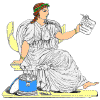The colours for the Tverski and
Pskovski regiments have the motif that was the same for all regiments raised
at the start of the war. The background colour of Tverski can easily be
changed in order to create a colour representing a different regiment and on
Pskovski the palm leaves and cross can also easily be changed.

